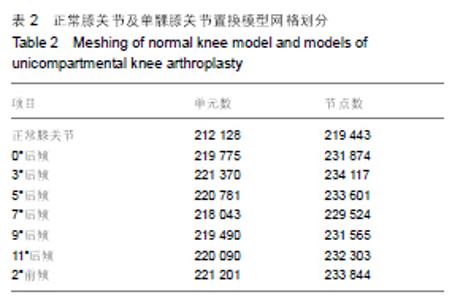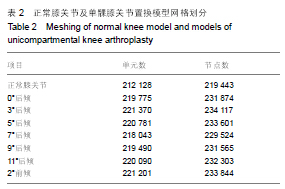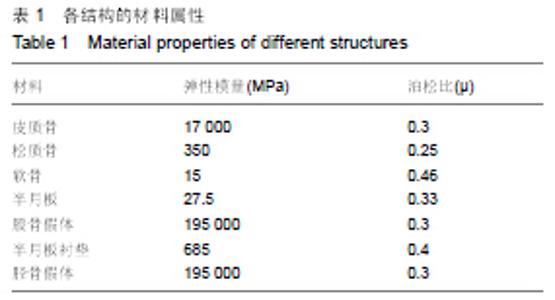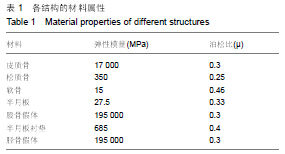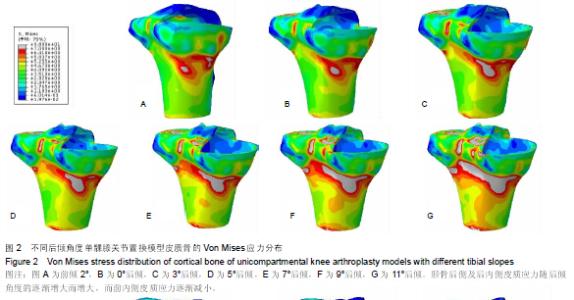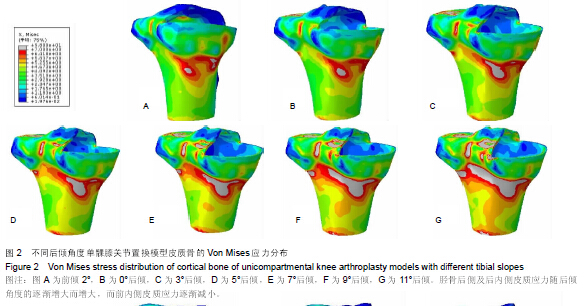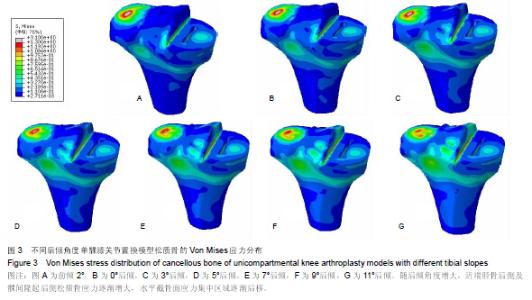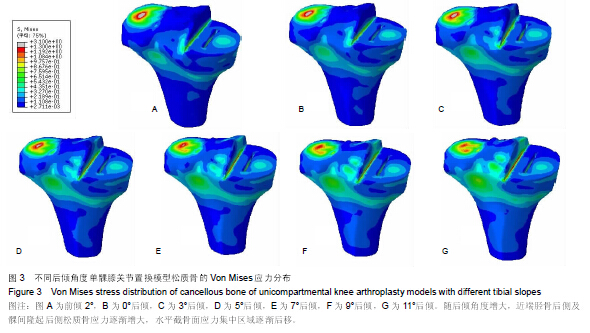Chinese Journal of Tissue Engineering Research ›› 2015, Vol. 19 ›› Issue (44): 7156-7162.doi: 10.3969/j.issn.2095-4344.2015.44.019
Previous Articles Next Articles
Finite element analysis of tibial slope in mobile-bearing unicompartmental knee arthroplasty
Zhu Guang-duo1, 2, Guo Wan-shou1, 2, Cheng Li-ming2, Liu Zhao-hui2, Zhang Qi-dong2
- 1Graduate School of Peking Union Medical College, Beijing 100730, China; 2Department of Bone and Joint Surgery, China-Japan Friendship Hospital, Beijing 100029, China
-
Received:2015-08-19Online:2015-10-22Published:2015-10-22 -
Contact:Guo Wan-shou, M.D., Chief physician, Graduate School of Peking Union Medical College, Beijing 100730, China; Department of Bone and Joint Surgery, China-Japan Friendship Hospital, Beijing 100029, China -
About author:Zhu Guang-duo, Studying for doctorate, Graduate School of Peking Union Medical College, Beijing 100730, China; Department of Bone and Joint Surgery, China-Japan Friendship Hospital, Beijing 100029, China
Cite this article
Zhu Guang-duo, Guo Wan-shou, Cheng Li-ming, Liu Zhao-hui, Zhang Qi-dong. Finite element analysis of tibial slope in mobile-bearing unicompartmental knee arthroplasty[J]. Chinese Journal of Tissue Engineering Research, 2015, 19(44): 7156-7162.
share this article
| [1] O'Rourke MR, Gardner JJ, Callaghan JJ, et al. The John Insall Award: unicompartmental knee replacement: a minimum twenty-one-year followup, end-result study. Clin Orthop Relat Res.2005;440:27-37. [2] Murray DW, Goodfellow JW, O’connor JJ. The Oxford Medial unicompartmental arthroplasty A Ten-Year Survival Study. J Bone Joint Surg Br.1998; 80(6):983-989.
[3] Hamilton WG, Ammeen D, Engh CA Jr, et al. Learning curve with minimally invasive unicompartmental knee arthroplasty. J Arthroplasty.2010;25(5):735-740.
[4] Müller PE, Pellengahr C, Witt M, et al. Influence of minimally invasive surgery on implant positioning and the functional outcome for medial unicompartmental knee arthroplasty.J Arthroplasty.2004;19(3):296-301.
[5] Zeng C, Cheng L, Wei J, et al. The influence of the tibial plateau slopes on injury of the anterior cruciate ligament: a meta-analysis. Knee Surg Sports Traumatol Arthrosc.2014; 22(1):53-65.
[6] Chatellard R, Sauleau V, Colmar M, et al. Medial unicompartmental knee arthroplasty: does tibial component position influence clinical outcomes and arthroplasty survival? Orthop Traumatol Surg Res.2013;99(4):S219-S225.
[7] Barbadoro P, Ensini A, Leardini A, et al. Tibial component alignment and risk of loosening in unicompartmental knee arthroplasty: a radiographic and radiostereometric study. Knee Surg Sports Traumatol Arthrosc.2014;22(12): 3157-3162.
[8] Giffin JR, Vogrin TM, Zantop T, et al. Effects of increasing tibial slope on the biomechanics of the knee. Am J Sports Med. 2004;32(2):376-382.
[9] Donzelli PS, Spilker RL, Ateshian GA, et al. Contact analysis of biphasic transversely isotropic cartilage layers and correlations with tissue failure. J Biomech.1999;32(10): 1037-1047.
[10] LeRoux MA, Setton LA. Experimental and biphasic FEM determinations of the material properties and hydraulic permeability of the meniscus in tension. J Biomech Eng.2002; 124(3): 315-321.
[11] Cowin SC. The mechanical and stress adaptive properties of bone.Ann Biomed Eng.1983;11(3-4): 263-295.
[12] Goldstein SA, Wilson DL, Sonstegard DA, et al. The mechanical properties of human tibial trabecular bone as a function of metaphyseal location. J Biomech.1983;16(12): 965-969.
[13] Peña E, Calvo B, Martinez MA, et al. Finite element analysis of the effect of meniscal tears and meniscectomies on human knee biomechanics. Clin Biomech (Bristol, Avon).2005;20(5): 498-507.
[14] Weiss JA, Gardiner JC. Computational modeling of ligament mechanics. Crit Rev Biomed Eng.2001;29(3):303-371.
[15] Bao HR, Zhu D, Gong H, et al. The effect of complete radial lateral meniscus posterior root tear on the knee contact mechanics: a finite element analysis. J Orthop Sci.2013;18(2): 256-263.
[16] Taylor M, Tanner KE, Freeman MA. Finite element analysis of the implanted proximal tibia: a relationship between the initial cancellous bone stresses and implant migration. J Biomech. 1998;31(4): 303-310.
[17] Yao J, Snibbe J, Maloney M, et al. Stresses and strains in the medial meniscus of an ACL deficient knee under anterior loading: a finite element analysis with image-based experimental validation. J Biomech Eng.2006;128(1): 135-141.
[18] Shepherd DE, Seedhom BB. The'instantaneous' compressive modulus of human articular cartilage in joints of the lower limb. Rheumatology (Oxford).1999;38(2): 124-132.
[19] Bendjaballah MZ, Shirazi-Adl A, Zukor DJ. Biomechanical response of the passive human knee joint under anterior-posterior forces. Clin Biomech (Bristol, Avon).1998; 13(8): 625-633.
[20] Peña E, Calvo B, Martinez MA, et al. A three-dimensional finite element analysis of the combined behavior of ligaments and menisci in the healthy human knee joint. J Biomech. 2006; 39(9): 1686-1701.
[21] Hopkins AR, New AM, Rodriguez-y-Baena F, et al. Finite element analysis of unicompartmental knee arthroplasty. Med Eng Phys.2010;32(1): 14-21.
[22] Mootanah R, Imhauser CW, Reisse F, et al. Development and validation of a computational model of the knee joint for the evaluation of surgical treatments for osteoarthritis. Comput Methods Biomech Biomed Engin.2014;17(13): 1502-1517.
[23] Moglo KE, Shirazi-Adl A. On the coupling between anterior and posterior cruciate ligaments, and knee joint response under anterior femoral drawer in flexion: a finite element study. Clin Biomech (Bristol, Avon).2003;18(8): 751-759.
[24] Peña E, Martinez MA, Calvo B, et al. A finite element simulation of the effect of graft stiffness and graft tensioning in ACL reconstruction. Clin Biomech (Bristol, Avon).2005;20(6): 636-644.
[25] Song Y, Debski RE, Musahl V, et al. A three-dimensional finite element model of the human anterior cruciate ligament: a computational analysis with experimental validation. J Biomech. 2004;37(3): 383-390.
[26] Pandit H, Jenkins C, Barker K, et al. The Oxford medial unicompartmental knee replacement using a minimally-invasive approach. J Bone Joint Surg Br.2006;88(1): 54-60.
[27] Kwon OR, Kang KT, Son J, et al. Biomechanical comparison of fixed-and mobile-bearing for unicomparmental knee arthroplasty using finite element analysis. J Orthop Res.2014; 32(2): 338-345.
[28] Crockett R, Roba M, Naka M, et al. Friction, lubrication, and polymer transfer between UHMWPE and CoCrMo hip‐implant materials: A fluorescence microscopy study. J Biomed Mater Res A.2009;89(4): 1011-1018.
[29] Innocenti B, Bilgen ÖF, Labey L, et al. Load Sharing and Ligament Strains in Balanced, Overstuffed and Understuffed UKA. A Validated Finite Element Analysis. J Arthroplasty. 2014; 29(7):1491-1498.
[30] Kurosawa H, Fukubayashi T, Nakajima H. Load-bearing mode of the knee joint: physical behavior of the knee joint with or without menisci. Clin Orthop Relat Res.1980;149: 283-290.
[31] Fukubayashi T, Kurosawa H. The contact area and pressure distribution pattern of the knee: a study of normal and osteoarthrotic knee joints. Acta Orthop Scand.1980;51(1-6): 871-879.
[32] Kim SJ, Bae JH, Lim HC. Factors affecting the postoperative limb alignment and clinical outcome after Oxford unicompartmental knee arthroplasty. J Arthroplasty.2012; 27(6):1210-1215.
[33] Konyves A, Willis-Owen CA, Spriggins AJ. The long-term benefit of computer-assisted surgical navigation in unicompartmental knee arthroplasty. J Orthop Surg Res. 2010;5(94): 54-59.
[34] Lewis JL, Lew WD, Schmidt J. Description and error evaluation of an in vitro knee joint testing system. J Biomech Eng.1988;110(3): 238-248.
[35] Simpson DJ, Price AJ, Gulati A, et al. Elevated proximal tibial strains following unicompartmental knee replacement-a possible cause of pain. Med Eng Phys.2009;31(7): 752-757.
[36] Small SR, Berend ME, Rogge RD, et al. Tibial loading after UKA: evaluation of tibial slope, resection depth, medial shift and component rotation. J Arthroplasty.2013;28(9): 179-183.
[37] Sawatari T, Tsumura H, Iesaka K, et al. Three‐dimensional finite element analysis of unicompartmental knee arthroplasty-the influence of tibial component inclination. J Orthop Res.2005;23(3): 549-554.
[38] Hernigou P, Deschamps G. Posterior slope of the tibial implant and the outcome of unicompartmental knee arthroplasty. J Bone Joint Surg Am.2004;86(3): 506-511.
[39] Aleto TJ, Berend ME, Ritter MA, et al. Early failure of unicompartmental knee arthroplasty leading to revision. J Arthroplasty.2008;23(2): 159-163.
[40] Hadley NA, Brown TD, Weinstein SL. The effects of contact pressure elevations and aseptic necrosis on the long-term outcome of congenital hip dislocation. J Orthop Res.1990;8(4): 504-513.
[41] Suero EM, Citak M, Cross MB, et al. Effects of tibial slope changes in the stability of fixed bearing medial unicompartmental arthroplasty in anterior cruciate ligament deficient knees. Knee.2012;19(4): 365-369.
[42] Weber P, Schröder C, Schmidutz F, et al. Increase of tibial slope reduces backside wear in medial mobile bearing unicompartmental knee arthroplasty. Clin Biomech (Bristol, Avon).2013;28(8): 904-909.
|
| [1] | Xu Feng, Kang Hui, Wei Tanjun, Xi Jintao. Biomechanical analysis of different fixation methods of pedicle screws for thoracolumbar fracture [J]. Chinese Journal of Tissue Engineering Research, 2021, 25(9): 1313-1317. |
| [2] | Zhang Tongtong, Wang Zhonghua, Wen Jie, Song Yuxin, Liu Lin. Application of three-dimensional printing model in surgical resection and reconstruction of cervical tumor [J]. Chinese Journal of Tissue Engineering Research, 2021, 25(9): 1335-1339. |
| [3] | Wei Wei, Li Jian, Huang Linhai, Lan Mindong, Lu Xianwei, Huang Shaodong. Factors affecting fall fear in the first movement of elderly patients after total knee or hip arthroplasty [J]. Chinese Journal of Tissue Engineering Research, 2021, 25(9): 1351-1355. |
| [4] | Wang Jinjun, Deng Zengfa, Liu Kang, He Zhiyong, Yu Xinping, Liang Jianji, Li Chen, Guo Zhouyang. Hemostatic effect and safety of intravenous drip of tranexamic acid combined with topical application of cocktail containing tranexamic acid in total knee arthroplasty [J]. Chinese Journal of Tissue Engineering Research, 2021, 25(9): 1356-1361. |
| [5] | Xiao Guoqing, Liu Xuanze, Yan Yuhao, Zhong Xihong. Influencing factors of knee flexion limitation after total knee arthroplasty with posterior stabilized prostheses [J]. Chinese Journal of Tissue Engineering Research, 2021, 25(9): 1362-1367. |
| [6] | Huang Zexiao, Yang Mei, Lin Shiwei, He Heyu. Correlation between the level of serum n-3 polyunsaturated fatty acids and quadriceps weakness in the early stage after total knee arthroplasty [J]. Chinese Journal of Tissue Engineering Research, 2021, 25(9): 1375-1380. |
| [7] | Zhang Chong, Liu Zhiang, Yao Shuaihui, Gao Junsheng, Jiang Yan, Zhang Lu. Safety and effectiveness of topical application of tranexamic acid to reduce drainage of elderly femoral neck fractures after total hip arthroplasty [J]. Chinese Journal of Tissue Engineering Research, 2021, 25(9): 1381-1386. |
| [8] | Chen Xinmin, Li Wenbiao, Xiong Kaikai, Xiong Xiaoyan, Zheng Liqin, Li Musheng, Zheng Yongze, Lin Ziling. Type A3.3 femoral intertrochanteric fracture with augmented proximal femoral nail anti-rotation in the elderly: finite element analysis of the optimal amount of bone cement [J]. Chinese Journal of Tissue Engineering Research, 2021, 25(9): 1404-1409. |
| [9] | Zhou Jihui, Li Xinzhi, Zhou You, Huang Wei, Chen Wenyao. Multiple problems in the selection of implants for patellar fracture [J]. Chinese Journal of Tissue Engineering Research, 2021, 25(9): 1440-1445. |
| [10] | Chen Junming, Yue Chen, He Peilin, Zhang Juntao, Sun Moyuan, Liu Youwen. Hip arthroplasty versus proximal femoral nail antirotation for intertrochanteric fractures in older adults: a meta-analysis [J]. Chinese Journal of Tissue Engineering Research, 2021, 25(9): 1452-1457. |
| [11] | Zeng Yanhua, Hao Yanlei. In vitro culture and purification of Schwann cells: a systematic review [J]. Chinese Journal of Tissue Engineering Research, 2021, 25(7): 1135-1141. |
| [12] | Xu Yulin, Shen Shi, Zhuo Naiqiang, Yang Huilin, Yang Chao, Li Yang, Zhao Heng, Zhao Lu. Biomechanical comparison of three different plate fixation methods for acetabular posterior column fractures in standing and sitting positions [J]. Chinese Journal of Tissue Engineering Research, 2021, 25(6): 826-830. |
| [13] | Cai Qunbin, Zou Xia, Hu Jiantao, Chen Xinmin, Zheng Liqin, Huang Peizhen, Lin Ziling, Jiang Ziwei. Relationship between tip-apex distance and stability of intertrochanteric femoral fractures with proximal femoral anti-rotation nail: a finite element analysis [J]. Chinese Journal of Tissue Engineering Research, 2021, 25(6): 831-836. |
| [14] | Zhao Zhongyi, Li Yongzhen, Chen Feng, Ji Aiyu. Comparison of total knee arthroplasty and unicompartmental knee arthroplasty in treatment of traumatic osteoarthritis [J]. Chinese Journal of Tissue Engineering Research, 2021, 25(6): 854-859. |
| [15] | Liu Shaohua, Zhou Guanming, Chen Xicong, Xiao Keming, Cai Jian, Liu Xiaofang. Influence of anterior cruciate ligament defect on the mid-term outcome of fixed-bearing unicompartmental knee arthroplasty [J]. Chinese Journal of Tissue Engineering Research, 2021, 25(6): 860-865. |
| Viewed | ||||||
|
Full text |
|
|||||
|
Abstract |
|
|||||
